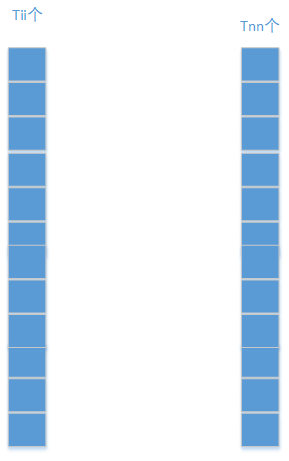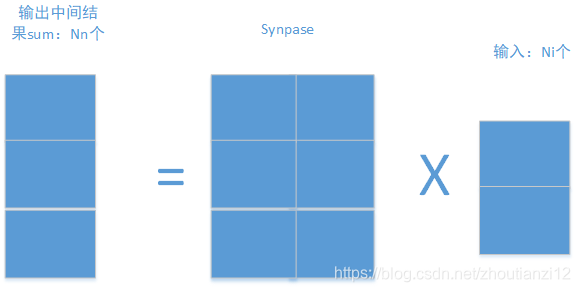2016:DianNao Family Energy-Efficient Hardware Accelerators for Machine Learning-程序员宅基地
技术标签: pr
文章目录
- 这个发表在了
- https://cacm.acm.org/
- communication of the ACM
- 上
- 参考文献链接是
Chen Y , Chen T , Xu Z , et al.
DianNao Family: Energy-Efficient Hardware Accelerators for Machine Learning[J].
Communications of the Acm, 2016, 59(11):105-112


- https://cacm.acm.org/magazines/2016/11/209123-diannao-family/fulltext
- 果然找到了他

- 特码的,我下载了,6不6
The original version of this paper is entitled “DianNao: A
Small-Footprint, High-Throughput Accelerator for Ubiq-
uitous Machine Learning” and was published in Proceed-
ings of the International Conference on Architectural Support
for Programming Languages and Operating Systems (ASPLOS)
49, 4 (March 2014), ACM, New York, NY, 269–284.
Abstract
- ML pervasive
- broad range of applications
- broad range of systems(embedded to data centers)
- broad range of applications
- computer
- toward heterogeneous multi-cores
- a mix of cores and hardware accelerators,
- designing hardware accelerators for ML
- achieve high efficiency and broad application scope
第二段
- efficient computational primitives
- important for a hardware accelerator,
- inefficient memory transfers can
- potentially void the throughput, energy, or cost advantages of accelerators,
- an Amdahl’s law effect
- become a first-order concern,
- like in processors,
- rather than an element factored in accelerator design on a second step
- a series of hardware accelerators
- designed for ML(nn),
- the impact of memory on accelerator design, performance, and energy.
- representative neural network layers
- 450.65x over GPU
- energy by 150.31x on average
- for 64-chip DaDianNao (a member of the DianNao family)
1 INTRODUCTION
- designing hardware accelerators which realize the best possible tradeoff between flexibility and efficiency is becoming a prominent
issue.
- The first question is for which category of applications one should primarily design accelerators?
- Together with the architecture trend towards accelerators, a second simultaneous and significant trend in high-performance and embedded applications is developing: many of the emerging high-performance and embedded applications, from image/video/audio recognition to automatic translation, business analytics, and robotics rely on machine learning
techniques. - This trend in application comes together with a third trend in machine learning (ML) where a small number
of techniques, based on neural networks (especially deep learning techniques 16, 26 ), have been proved in the past few
years to be state-of-the-art across a broad range of applications. - As a result, there is a unique opportunity to design accelerators having significant application scope as well as
high performance and efficiency. 4
第二段
- Currently, ML workloads
- mostly executed on
- multicores using SIMD[44]
- on GPUs[7]
- or on FPGAs[2]
- the aforementioned trends
- have already been identified
- by researchers who have proposed accelerators implementing,
- CNNs[2]
- Multi-Layer Perceptrons [43] ;
- accelerators focusing on other domains,
- image processing,
- propose efficient implementations of some of the computational primitives used
- by machine-learning techniques, such as convolutions[37]
- There are also ASIC implementations of ML
- such as Support Vector Machine and CNNs.
- these works focused on
- efficiently implementing the computational primitives
- ignore memory transfers for the sake of simplicity[37,43]
- plug their computational accelerator to memory via a more or less sophisticated DMA. [2,12,19]
- efficiently implementing the computational primitives
第三段
-
While efficient implementation of computational primitives is a first and important step with promising results,
inefficient memory transfers can potentially void the throughput, energy, or cost advantages of accelerators, that is, an
Amdahl’s law effect, and thus, they should become a first-
order concern, just like in processors, rather than an element
factored in accelerator design on a second step. -
Unlike in processors though, one can factor in the specific nature of
memory transfers in target algorithms, just like it is done for accelerating computations. -
This is especially important in the domain of ML where there is a clear trend towards scaling up the size of learning models in order to achieve better accuracy and more functionality. 16, 24
第四段
- In this article, we introduce a series of hardware accelerators designed for ML (especially neural networks), including
DianNao, DaDianNao, ShiDianNao, and PuDianNao as listed in Table 1. - We focus our study on memory usage, and we investigate the accelerator architecture to minimize memory
transfers and to perform them as efficiently as possible.
2 DIANNAO: A NN ACCELERATOR
- DianNao
- first of DianNao accelerator family,
- accommodates sota nn techniques (dl ),
- inherits the broad application scope of nn.
2.1 Architecture
- DianNao
- input buffer for input (NBin)
- output buffer for output (NBout)
- buffer for synaptic(突触) weights (SB)
- connected to a computational block (performing both synapses and neurons computations)
- NFU, and CP, see Figure 1

NBin是存放输入神经元
SB是存放突触的权重的
这个NBout是存放输出神经元
我觉得图示的可以这样理解:2个输入神经元,2个突触,将这2个对应乘起来,输出是1个神经元啊。但是我的这个NFU牛逼啊,他可以一次性求两个输出神经元。
NFU
- a functional block of T i T_i Ti inputs/synapses(突触)
- T n T_n Tn output neurons,
- time-shared by different algorithmic blocks of neurons.
这个NFU对 T i T_i Ti个输入和突触运算,得到 T n T_n Tn个输出神经元,突触不是应该是 T i × T n T_i\times T_n Ti×Tn个吗??,
- Depending on the layer type,
- computations at the NFU can be decomposed in either two or three stages
- For classifier and convolutional:
- multiplication of synapses × \times × inputs:NFU-1
- , additions of all multiplications, :NFU-2
- sigmoid. :NFU-3
如果是分类层或者卷积的话的话,那就是简单的突触 × \times × 输入,然后加起来,求sigmoid。这个我能理解哦,这种情况不就是卷积吗。
如果是分类层,那么输入就是
- last stage (sigmoid or another nonlinear function) can vary.
- For pooling, no multiplication(no synapse),
- pooling can be average or max.
- adders(加法器) have multiple inputs,
- they are in fact adder trees,
- the second stage also contains
- shifters and max operators for pooling.
要啥移位啊??
- the sigmoid function (for classifier and convolutional layers)can be efficiently implemented using ( f ( x ) = a i x × + b i , x ∈ [ x i , x i + 1 ] f(x) = a_i x \times + b_i , x \in [x_i , x_{i+1} ] f(x)=aix×+bi,x∈[xi,xi+1]) (16 segments are sufficient)
On-chip Storage
- on-chip storage structures of DianNao
- can be construed as modified buffers of scratchpads.
- While a cache is an excellent storage structure for a general-purpose processor, it is a sub-optimal way to exploit reuse because of the cache access overhead (tag check, associativity, line size, speculative read, etc.) and cache conflicts.
- The efficient alternative, scratchpad, is used in VLIW processors but it is known to be very difficult to compile for.
- However a scratchpad in a dedicated accelerator realizes the best of both worlds: efficient
storage, and both efficient and easy exploitation of locality because only a few algorithms have to be manually adapted.
第二段
- on-chip storage into three (NBin, NBout,and SB), because there are three type of data (input neurons,output neurons and synapses) with different characteristics (read width and reuse distance).
- The first benefit of splitting structures is to tailor the SRAMs to the appropriate
read/write width, - and the second benefit of splitting storage structures is to avoid conflicts, as would occur in a cache.
- Moreover, we implement three DMAs to exploit spatial locality of data, one for each buffer (two load DMAs for inputs, one store DMA for outputs).
2.2 Loop tiling
- DianNao 用 loop tiling去减少memory access
- so可容纳大的神经网络
- 举例
- 一个classifier 层
- 有 N n N_n Nn输出神经元
- 全连接到 N i N_i Ni的输入
- 如下图
- 一个classifier 层


N n N_n Nn个输出, N i N_i Ni个输入,sypase应该是 N n × N i N_n\times N_i Nn×Ni大小,用这个矩阵 × N i \times N_i ×Ni即可得到结果啊
- 先取出来一块
- 有点疑惑啊
- 万一右边第一个元素和左边全部元素都有关
- 你咋算啊 ()
- 其实啊,我他妈算右边第一个时候
- 只需要用到和synapse的一行呀!
- 那你那个大大的synapse矩阵咋办啊

- 下面是原始代码和和
- tiled代码
- 他把分类层映射到DianNao

for(int n=0;n<Nn;n++)
sum[n]=0;
for(int n=0;n<Nn;n++) //输出神经元
for(int i=0;i<Ni;i++) //输入神经元
sum[n]+=synapse[n][i]*neuron[i];
for(int n=0;n<Nn;n++)
neuron[n]=Sigmoid(sum[n]);
- 俺的想法:
- 一次来Tnn个输出
- 和Tii个输入
- 然后这个东西对于硬件还是太大了
- 再拆
- 来Tn个和Ti个吧
- 就酱
for(int nnn=0;nnn<Nn;nnn+=Tnn){
//tiling for output 神经元
//第一个for循环准备扔出去Tnn个输出
for(int iii=0;iii<Ni;iii+=Tii){
//tiling for input 神经元
//第二个for循环准备扔进来Tii个输入
//下面就这两个东西动手
for(int nn=nnn;nn<nnn+Tnn;nn+=Tn){
//第三个for循环觉得觉得Tnn还是太大了,继续拆
//大小是Tn
//那么我们对每一个Tnn块!(开始位置是nn哦!!)
//我们如下求解
///
for(int n=nn;n<nn+Tn;n++)
//第一步把中间结果全部搞成零!
sum[n]=0;
//为求sum[n],sum[n]=synapse的第n行乘neuron的全部啊!
for(int ii=iii;ii<iii+Tii;ii+=Ti)
//上面的for是对Ti进行拆
for(int n=nn;n<nn+Tn;n++)
for(int i=ii;i<ii+Ti;i++)
sum[n]+=synapse[n][i]*neuron[i];
for(int nn=nnn;nn<nnn+Tnn;nn+=Tn)
neuron[n]=sigmoid(sum[n]);
///
} } }
- 在tiled代码中, i i ii ii和 n n nn nn
- 表示NFU有 T i T_i Ti个输入和突触
- 和 T n T_n Tn个输出神经元
- 表示NFU有 T i T_i Ti个输入和突触
- 输入神经元被每个输出神经元需要重用
- 但这个输入向量也太他妈大了
- 塞不到Nbin块里啊
- 所以也要对循环 i i ii ii分块,因子 T i i T_{ii} Tii
上面的代码肯定有问题,正确的如下:
for (int nnn = 0; nnn < Nn; nnn += Tnn) {
for (int nn = nnn; nn < nnn + Tnn; nn += Tn) {
for (int n = nn; n < nn + Tn; n++)
sum[n] = 0;
for (int iii = 0; iii < Ni; iii += Tii) {
for (int ii = iii; ii < iii + Tii; ii += Ti)
for (int n = nn; n < nn + Tn; n++)
for (int i = ii; i < ii + Ti; i++)
sum[n] += synapse[n][i] * neuron[i];
}
for (int n = nn; n < nn + Tn; n++)
printf("s%ds ", sum[n]);
}
}
for (int index = 0; index < Nn; index++)
printf("%d ", sum[index]);
智能推荐
获取大于等于一个整数的最小2次幂算法(HashMap#tableSizeFor)_整数 最小的2的几次方-程序员宅基地
文章浏览阅读2w次,点赞51次,收藏33次。一、需求给定一个整数,返回大于等于该整数的最小2次幂(2的乘方)。例: 输入 输出 -1 1 1 1 3 4 9 16 15 16二、分析当遇到这个需求的时候,我们可能会很容易想到一个"笨"办法:..._整数 最小的2的几次方
Linux 中 ss 命令的使用实例_ss@,,x,, 0-程序员宅基地
文章浏览阅读865次。选项,以防止命令将 IP 地址解析为主机名。如果只想在命令的输出中显示 unix套接字 连接,可以使用。不带任何选项,用来显示已建立连接的所有套接字的列表。如果只想在命令的输出中显示 tcp 连接,可以使用。如果只想在命令的输出中显示 udp 连接,可以使用。如果不想将ip地址解析为主机名称,可以使用。如果要取消命令输出中的标题行,可以使用。如果只想显示被侦听的套接字,可以使用。如果只想显示ipv4侦听的,可以使用。如果只想显示ipv6侦听的,可以使用。_ss@,,x,, 0
conda activate qiuqiu出现不存在activate_commandnotfounderror: 'activate-程序员宅基地
文章浏览阅读568次。CommandNotFoundError: 'activate'_commandnotfounderror: 'activate
Kafka 实战 - Windows10安装Kafka_win10安装部署kafka-程序员宅基地
文章浏览阅读426次,点赞10次,收藏19次。完成以上步骤后,您已在 Windows 10 上成功安装并验证了 Apache Kafka。在生产环境中,通常会将 Kafka 与外部 ZooKeeper 集群配合使用,并考虑配置安全、监控、持久化存储等高级特性。在生产者窗口中输入一些文本消息,然后按 Enter 发送。ZooKeeper 会在新窗口中运行。在另一个命令提示符窗口中,同样切换到 Kafka 的。Kafka 服务器将在新窗口中运行。在新的命令提示符窗口中,切换到 Kafka 的。,应显示已安装的 Java 版本信息。_win10安装部署kafka
【愚公系列】2023年12月 WEBGL专题-缓冲区对象_js 缓冲数据 new float32array-程序员宅基地
文章浏览阅读1.4w次。缓冲区对象(Buffer Object)是在OpenGL中用于存储和管理数据的一种机制。缓冲区对象可以存储各种类型的数据,例如顶点、纹理坐标、颜色等。在渲染过程中,缓冲区对象中存储的数据可以被复制到渲染管线的不同阶段中,例如顶点着色器、几何着色器和片段着色器等,以完成渲染操作。相比传统的CPU访问内存,缓冲区对象的数据存储和管理更加高效,能够提高OpenGL应用的性能表现。_js 缓冲数据 new float32array
四、数学建模之图与网络模型_图论与网络优化数学建模-程序员宅基地
文章浏览阅读912次。(1)图(Graph):图是数学和计算机科学中的一个抽象概念,它由一组节点(顶点)和连接这些节点的边组成。图可以是有向的(有方向的,边有箭头表示方向)或无向的(没有方向的,边没有箭头表示方向)。图用于表示各种关系,如社交网络、电路、地图、组织结构等。(2)网络(Network):网络是一个更广泛的概念,可以包括各种不同类型的连接元素,不仅仅是图中的节点和边。网络可以包括节点、边、连接线、路由器、服务器、通信协议等多种组成部分。网络的概念在各个领域都有应用,包括计算机网络、社交网络、电力网络、交通网络等。_图论与网络优化数学建模
随便推点
android 加载布局状态封装_adnroid加载数据转圈封装全屏转圈封装-程序员宅基地
文章浏览阅读1.5k次。我们经常会碰见 正在加载中,加载出错, “暂无商品”等一系列的相似的布局,因为我们有很多请求网络数据的页面,我们不可能每一个页面都写几个“正在加载中”等布局吧,这时候将这些状态的布局封装在一起就很有必要了。我们可以将这些封装为一个自定布局,然后每次操作该自定义类的方法就行了。 首先一般来说,从服务器拉去数据之前都是“正在加载”页面, 加载成功之后“正在加载”页面消失,展示数据;如果加载失败,就展示_adnroid加载数据转圈封装全屏转圈封装
阿里云服务器(Alibaba Cloud Linux 3)安装部署Mysql8-程序员宅基地
文章浏览阅读1.6k次,点赞23次,收藏29次。PS: 如果执行sudo grep 'temporary password' /var/log/mysqld.log 后没有报错,也没有任何结果显示,说明默认密码为空,可以直接进行下一步(后面设置密码时直接填写新密码就行)。3.(可选)当操作系统为Alibaba Cloud Linux 3时,执行如下命令,安装MySQL所需的库文件。下面示例中,将创建新的MySQL账号,用于远程访问MySQL。2.依次运行以下命令,创建远程登录MySQL的账号,并允许远程主机使用该账号访问MySQL。_alibaba cloud linux 3
excel离散度图表怎么算_excel离散数据表格-Excel 离散程度分析图表如何做-程序员宅基地
文章浏览阅读7.8k次。EXCEL中数据如何做离散性分析纠错。离散不是均值抄AVEDEV……=AVEDEV(A1:A100)算出来的是A1:A100的平均数。离散是指各项目间指标袭的离散均值(各数值的波动情况),数值较低表明项目间各指标波动幅百度小,数值高表明波动幅度较大。可以用excel中的离散公式为STDEV.P(即各指标平均离散)算出最终度离散度。excel表格函数求一组离散型数据,例如,几组C25的...用exc..._excel数据分析离散
学生时期学习资源同步-JavaSE理论知识-程序员宅基地
文章浏览阅读406次,点赞7次,收藏8次。i < 5){ //第3行。int count;System.out.println ("危险!System.out.println(”真”);System.out.println(”假”);System.out.print(“姓名:”);System.out.println("无匹配");System.out.println ("安全");
linux 性能测试磁盘状态监测:iostat监控学习,包含/proc/diskstats、/proc/stat简单了解-程序员宅基地
文章浏览阅读3.6k次。背景测试到性能、压力时,经常需要查看磁盘、网络、内存、cpu的性能值这里简单介绍下各个指标的含义一般磁盘比较关注的就是磁盘的iops,读写速度以及%util(看磁盘是否忙碌)CPU一般比较关注,idle 空闲,有时候也查看wait (如果wait特别大往往是io这边已经达到了瓶颈)iostatiostat uses the files below to create ..._/proc/diskstat
glReadPixels读取保存图片全黑_glreadpixels 全黑-程序员宅基地
文章浏览阅读2.4k次。问题:在Android上使用 glReadPixel 读取当前渲染数据,在若干机型(华为P9以及魅族某魅蓝手机)上读取数据失败,glGetError()没有抓到错误,但是获取到的数据有误,如果将获取到的数据保存成为图片,得到的图片为黑色。解决方法:glReadPixels实际上是从缓冲区中读取数据,如果使用了双缓冲区,则默认是从正在显示的缓冲(即前缓冲)中读取,而绘制工作是默认绘制到后缓..._glreadpixels 全黑